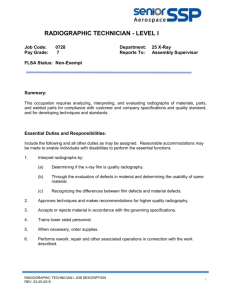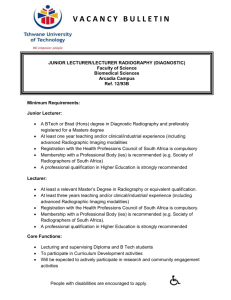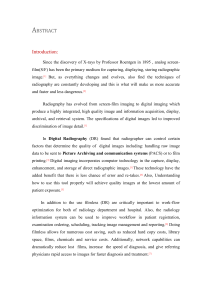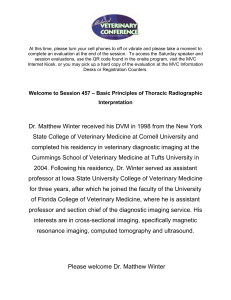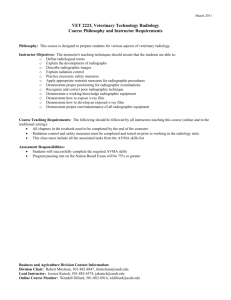Slide 1 HEALTH PROFESSIONS: The Core Two
advertisement
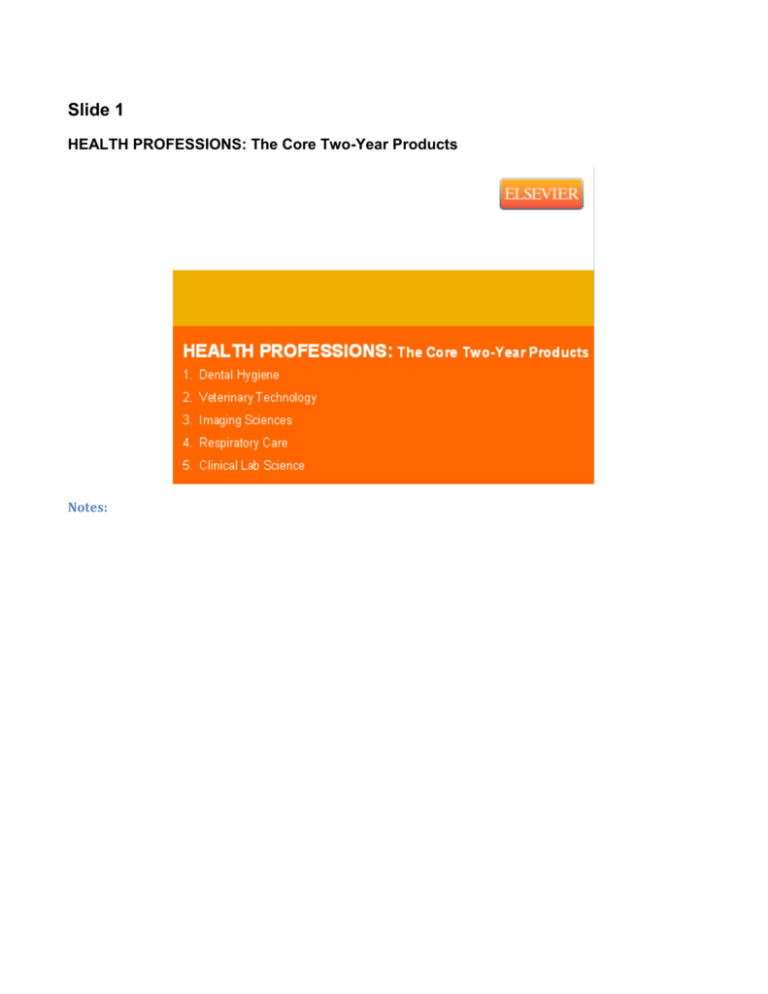
Slide 1 HEALTH PROFESSIONS: The Core Two-Year Products Notes: Slide 2 Dental Hygiene Notes: Dental hygienists, are different from assistants, because they also examine patients’ teeth and gums, remove stains and plaque from teeth, and take and develop dental x-rays among other responsibilities. Employment of dental hygienists is expected to grow 30% through 2016. Slide 3 Core Texts Notes: Elsevier publishes two core textbooks in dental hygiene. The core textbooks cover all the curriculum requirements. And we also have a full publishing program to satisfy courses that require more depth of content across the curriculum. Of our two core textbooks, Darby/Walsh has a strong clinical emphasis and a more advanced approach. It is a “practice-oriented” package. Daniel is comprehensive but more straightforward in its approach. Designed for the classroom environment, this package includes a CD-ROM and an Evolve website. Be persistent in selling both Darby and Daniel in your programs; many courses will require 2 core textbooks (some combination of Darby, Daniel, and our competitor, Wilkens), so make sure at least one of them is from Elsevier! Slide 4 Dental Hygiene Curriculum Notes: Slide 5 Veterinary Technology Notes: The veterinary technician assists in the care and handling of animals and in routine laboratory and clinical procedures. We are the market leader and continue to publish new Veterinary Technology books to meet market needs. Slide 6 Core Texts Notes: We have two core textbooks in Veterinary Technology. Bassert: McCurnin’s Clinical Textbook for Veterinary Technician’s is the market leader and the most comprehensive of our offerings. It covers the essentials and includes more content on large animal and advanced procedures. Sirois is focused on essentials and built to be easily approachable for students at all levels. Slide 7 Anatomy and Physiology Notes: Anatomy and physiology are key components of the veterinary technology curriculum. Since the publication of the first edition of Colville, it has filled a critical need in the vet tech curriculum because it is designed as a basic text that focuses on essential content needed to understand the clinical relevance of anatomical and physiological principles. Colville is a comprehensive text covering all major species: dogs, cats, horses, cattle, and birds, it covers essential anatomy and physiology principles needed by veterinary technicians, with practical application and is written by nationally renowned veterinary technician educators specifically for technicians. It is also one of the best-selling books on this list. Slide 8 Imaging Science/Radiography Notes: Imaging Sciences includes the diagnostic modalities of radiography, sonography, nuclear medicine, magnetic resonance imaging (MRI), computed tomography (CT), and the therapeutic modality of radiation therapy. Radiography is the largest of the imaging sciences with over 600 programs and nearly 18,000 students. Programs are generally 2 to 4 years in length, depending on the degree or certificate awarded. We estimate that Elsevier owns approximately 80-90% market share in general radiography and the majority of the market share in specialty areas. If you’re having a bad day, visit your Radiography program—this segment brings in a lot of revenue. Radiography also offers a wide variety of electronic solutions for our customers—from traditional texts, to online courses to testing & remediation, you will have a large bookbag to sell from when you visit these programs. Slide 9 Fundamentals Notes: Fundamentals of Radiologic Science and Patient Care is a curriculum requirement. We have three books in this area. Both Adler and Ehrlich offer an introduction to radiography and patient care in one text, making it the ideal book for programs that combine their intro and patient care courses. Gurley and Callaway, provides information needed by students taking an introduction to radiography course, but offers only an overview of patient care. Slide 10 Image Analysis SLIDE CHANGES: Move Fauber: Radiographic Imaging & Exposure book image to the middle. Notes: Image Analysis is another curriculum requirement. Again, we have three possible texts in this area. Bushong is widely used in education programs to teach the science of medical imaging. It is firmly established as a core textbook for students in the various medical imaging programs. Fauber: Radiographic Imaging & Exposure emphasizes the fundamentals that must be understood clearly and applied to practice to reduce the number of repeated radiographs. Fauber’s concise, straightforward writing style enhances student comprehension. McQuillen Martensen: Radiographic Image Analysis, is the only text available devoted entirely to improving radiographic positioning and technique. Slide 11 Radiation Protection Notes: For Radiation Protection, Elsevier has two books: Bushong and Sherer. Bushong covers a large percentage of the radiography curriculum, including radiation protection. Instructors like it because students can buy one book to use in several courses. However, radiation protection is presented in less depth than in Sherer, which offers an attractive alternative for programs that want more coverage of radiation protection. Slide 12 Radiographic Pathology Notes: Let’s move on to Radiographic Pathology. We have two books in this area as well : Eisenberg and Kowalczyk [Ka-wal-chik]. Kowalczyk is an “essentials” book that concisely presents the pathologic processes most likely to be diagnosed using medical imaging. Eisenberg covers core curriculum content for radiography students and provides the most complete reference available on this topic. Slide 13 Radiographic Procedures SLIDE CHANGES: Flip flop order of book images. Notes: Finally, Radiographic Procedures. Two of our biggest books on the imaging sciences list include Frank: Merrill’s Atlas of Radiographic Positioning & Procedures and Bontrager: Textbook of Radiographic Positioning and Related Anatomy. Instructors tend to be loyal to their core textbook. The choice of one of these titles is really a personal preference for instructors – both books cover the same material with Merrill’s being more comprehensive and packaged in 3 volumes. Slide 14 Mosby's Radiography Online Notes: For Radiography, we offer an entire curriculum of online courses to accompany the texts. Many of the courses are textbook neutral, meaning they were built to accompany any textbook on the particular subject. From Anatomy & Positioning, to Patient Care, to Radiation Protection and more, our MROs were built for use across the many subject areas in the curriculum. We also have MRO courses that were developed specifically for Bontrager, Frank: Merrill’s Atlas and Johnston. These are the only three MRO offerings that are specific to a textbook. Slide 15 Respiratory Care Notes: Respiratory Care programs teach students to evaluate, treat, and manage patients of all ages with respiratory illnesses and other cardiopulmonary disorders. These are usually 2- or 4-year programs, primarily in colleges and universities, but growing in the career and community college segment. Elsevier is the market leader in this area, and instructors tend to be very loyal. Slide 16 Core Text Notes: Our core textbook in this area is Kacmarek: Egan’s Fundamentals of Respiratory Care. It is the most established book in the market – the most comprehensive and is by far the market leader. We also have Mosby’s Respiratory Care Online that you can add to the program, providing a full interactive online experience to complement the core textbook. Lung & Heart Sounds Online is a case-based approach resource that features animations, videos, and audio of heart and lung sounds to teach students how to accurately assess and interpret cardiopulmonary auscultation. This course is on Evolve and can be used in other disciplines including nursing, EMT/Paramedic and medical. We have a full list of titles to meet all the curriculum needs in this area. Assessment, respiratory care equipment, mechanical ventilation, and certification exam review are all areas that will be taught in these programs—you will get multiple titles adopted in this program across the curriculum. Slide 17 Clinical Lab Science Notes: Clinical Lab Science (CLS) includes eight different subgroups that make up this discipline. These eight areas include: • Clinical Assistant • Clinical Laboratory Scientist (or Medical Technologist) • Clinical Laboratory Technician (or Medical Laboratory Technologist) • Cytogenetic Technologist • Diagnostic Molecular Scientist • Histologic technician (or Histotechnologist) • Pathologist Assistant, and • Phlebotomist Within CLS there are 2 year programs and 4 year programs for a lot of areas. Elsevier is unique because we often offer comprehensive texts for the longer programs and a simplified version for the shorter programs. It is important that we leverage our unique advantage to stay ahead of the competition. Slide 18 Hematology Notes: For Hematology the core title to focus on is Rodak: Hematology. This is not the market leader, but a strong competitor. Slide 19 Microbiology Notes: We are the market leader for microbiology and the text to focus on for that curriculum is Forbes: Bailey & Scott’s Diagnostic Microbiology. The other microbiology book on our list is written by Mahon. Mahon is one of the only texts in the market written exclusively for students in both two and four year programs. Although Mahon is lowerlevel than Bailey & Scott’s, it is a higher-level than some of our competitors’ books which only focus on 2 year programs. Slide 20 Roles & Responsibility Notes: For programs covering Roles & Responsibility of the MLT/Roles & Responsibility of the MLT Lab, your textbook is Turgeon: Linne & Ringsrud’s Clinical Laboratory Science 6e, which is the market leader. Slide 21 Clinical Chemistry Notes: In Clinical Chemistry we have two main titles to focus on, Kaplan: Clinical Chemistry and the comprehensive, Burtis: Tietz Textbook of Clinical Chemistry and Molecular Diagnostics. Tietz is the biggest name in Clinical Lab Science and is very respected amongst students and faculty. Slide 22 Phlebotomy Notes: For phlebotomy programs, Warekois (Wear-Coy) Phlebotomy is the core text. Based on Warekois (Wear-Coy), Phlebotomy Exam Review by Primrose is an excellent way for students to prepare for the certification exams. McCall is our primary target, having been on the market first. Their book is tied to McCall Phlebotomy. For programs using Warekois, our book is the best alternative for phlebotomy review. Slide 23 Immunology Notes: Immunology, another area in CLS, mainly uses the Turgeon: Immunology & Serology in Laboratory Medicine which is the market leader. Slide 24 Clinical Lab Science Curriculum Notes: Slide 25 Test Yourself PROPERTIES On passing, 'Finish' button: On failing, 'Finish' button: Allow user to leave quiz: User may view slides after quiz: User may attempt quiz: Notes: Goes to Next Slide Goes to Next Slide After user has completed quiz At any time Unlimited times Slide 26 Congratulations! Notes:


